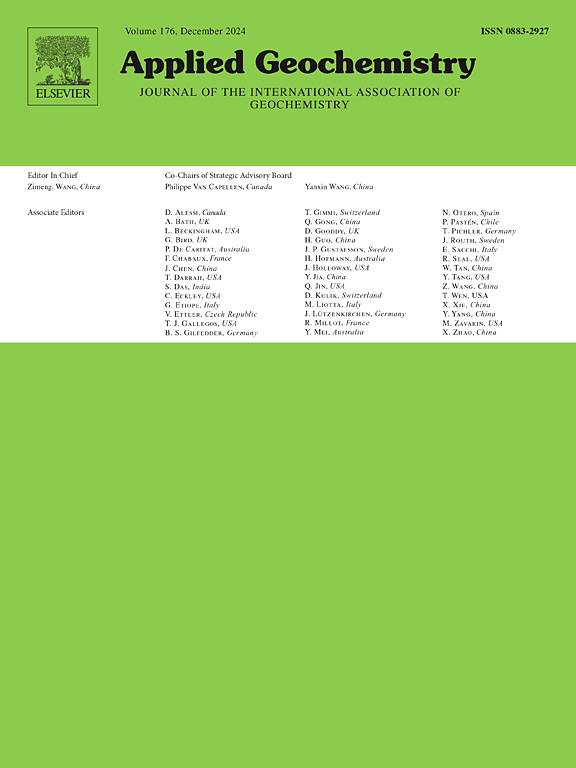高放废物储存库地球化学演化反应输运模型的全球敏感性分析
IF 3.1
3区 地球科学
Q1 GEOCHEMISTRY & GEOPHYSICS
引用次数: 0
摘要
反应输运模型用于高放废物处置库(HLW)的性能评估。对模型不确定性进行量化,需要识别对模型输出影响最大、对预测不确定性影响最大的参数。在分析数值模型结果的基础上,提出了先进的灵敏度分析方法,如Morris初等效应和Sobol提出的高维模型降阶(High Dimensional model Reduction, HDMR)方法。响应面方差分析(Variogram Analysis of Response Surfaces)是一种基于方差的分析模型输出结构的方法。在这里,我们报告了VARS和HDMR的应用,用于评估花岗岩中高浓缩铀储库的金属罐和膨润土缓冲层的反应传输模型预测的全局敏感性。在t = 1·104、2.5·104和5·104年时,分析了罐/膨润土界面处的pH、氧化还原电位和腐蚀产物体积的整体灵敏度。输入参数包括:金属罐的腐蚀速率(CR)、膨润土孔隙水扩散系数(De)、通过花岗岩主岩的地下水流量(Qgra)、铁的阳离子交换选择性(KFe)和磁铁矿的溶解度(Log K)。VARS和HDMR结果表明,对pH影响最大的输入参数是CR、Qgra和KFe。pH对CR和KFe参数的敏感性指数随时间增加,而磁铁矿的对数K的敏感性指数随时间降低。而De的灵敏度指数随时间保持不变。与pH相似,对Eh影响最大的参数是CR和Qgra。Eh对磁铁矿CR和K的灵敏度随时间降低,而Qgra的灵敏度随时间增加。在t = 5·104年时,用HDMR指数计算的pH和Eh参数之间的主要相互作用发生在CR和Qgra之间。与pH和Eh类似,CR是对腐蚀产物体积影响最大的参数,而De是第二重要的参数。腐蚀产物体积的敏感性指标除CR外均随时间增加,Sobol和VARS的参数排序基本一致。本文章由计算机程序翻译,如有差异,请以英文原文为准。

Global sensitivity analysis of reactive transport modelling for the geochemical evolution of a high-level radioactive waste repository
Reactive transport models are used for the performance assessment of high-level radioactive waste repositories (HLW). Quantifying model uncertainty requires the identification of the parameters having the most significant effect on model outputs and the largest impact on prediction uncertainties. Sophisticated sensitivity analysis methods have been developed for numerical models based on the analysis of model results such as the Morris elementary effects and the High Dimensional Model Reduction (HDMR) method proposed by Sobol. VARS (Variogram Analysis of Response Surfaces) is a variance-based method to analyze the structure of a model output. Here we report the application of VARS and HDMR for evaluating the global sensitivities of the predictions of a reactive transport model of the metallic canister and bentonite buffer of a HLW repository in granitic rock. Global sensitivities are analyzed for pH, redox potential and volume of corrosion products at the canister/bentonite interface at t = 1·104, 2.5·104 and 5·104 years. The input parameters include: the corrosion rate of the metallic canister (CR), the bentonite porewater diffusion coefficient (De), the groundwater flow through the granitic host rock (Qgra), the cation exchange selectivity of Fe (KFe) and the solubility of magnetite (Log K). VARS and HDMR results show that the most influential input parameters for pH are CR, Qgra and KFe. The sensitivity indexes of pH for parameters CR and KFe increase with time while that of log K of magnetite decreases. The sensitivity index of De, however, remains constant in time. Similar to pH, the most influential parameters for Eh are CR and Qgra. The sensitivity indexes of Eh for CR and log K of magnetite decrease with time while that of Qgra increases with time. The main interactions between parameters computed with HDMR indexes for pH and Eh at t = 5·104 years occur between CR and Qgra. Similar to pH and Eh, CR is the most influential parameter for the volume of corrosion products while De is the second most relevant. All the sensitivity indexes for the volume of corrosion products increase with time except for CR. Parameter rankings of Sobol and VARS are nearly identical.
求助全文
通过发布文献求助,成功后即可免费获取论文全文。
去求助
来源期刊

Applied Geochemistry
地学-地球化学与地球物理
CiteScore
6.10
自引率
8.80%
发文量
272
审稿时长
65 days
期刊介绍:
Applied Geochemistry is an international journal devoted to publication of original research papers, rapid research communications and selected review papers in geochemistry and urban geochemistry which have some practical application to an aspect of human endeavour, such as the preservation of the environment, health, waste disposal and the search for resources. Papers on applications of inorganic, organic and isotope geochemistry and geochemical processes are therefore welcome provided they meet the main criterion. Spatial and temporal monitoring case studies are only of interest to our international readership if they present new ideas of broad application.
Topics covered include: (1) Environmental geochemistry (including natural and anthropogenic aspects, and protection and remediation strategies); (2) Hydrogeochemistry (surface and groundwater); (3) Medical (urban) geochemistry; (4) The search for energy resources (in particular unconventional oil and gas or emerging metal resources); (5) Energy exploitation (in particular geothermal energy and CCS); (6) Upgrading of energy and mineral resources where there is a direct geochemical application; and (7) Waste disposal, including nuclear waste disposal.
 求助内容:
求助内容: 应助结果提醒方式:
应助结果提醒方式:


